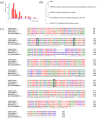Novel recombinant keratin degrading subtilisin like serine alkaline protease from Bacillus cereus isolated from marine hydrothermal vent crabs
- PMID: 34099743
- PMCID: PMC8185006
- DOI: 10.1038/s41598-021-90375-4
Novel recombinant keratin degrading subtilisin like serine alkaline protease from Bacillus cereus isolated from marine hydrothermal vent crabs
Abstract
Microbial secondary metabolites from extreme environments like hydrothermal vents are a promising source for industrial applications. In our study the protease gene from Bacillus cereus obtained from shallow marine hydrothermal vents in the East China Sea was cloned, expressed and purified. The protein sequence of 38 kDa protease SLSP-k was retrieved from mass spectrometry and identified as a subtilisin serine proteinase. The novel SLSP-k is a monomeric protein with 38 amino acid signal peptides being active over wide pH (7-11) and temperature (40-80 °C) ranges, with maximal hydrolytic activities at pH 10 and at 50 °C temperature. The hydrolytic activity is stimulated by Ca2+, Co2+, Mn2+, and DTT. It is inhibited by Fe2+, Cd2+, Cu2+, EDTA, and PMSF. The SLSP-k is stable in anionic, non-anionic detergents, and solvents. The ability to degrade keratin in chicken feather and hair indicates that this enzyme is suitable for the degradation of poultry waste without the loss of nutritionally essential amino acids which otherwise are lost in hydrothermal processing. Therefore, the proteinase is efficient in environmental friendly bioconversion of animal waste into fertilizers or value added products such as secondary animal feedstuffs.
Conflict of interest statement
The authors declare no competing interests.
Figures





References
-
- Dahms H-U, Schizas NV, James RA, Wang L, Hwang J-S. Marine hydrothermal vents as templates for global change scenarios. Hydrobiologia. 2018;818:1–10. doi: 10.1007/s10750-018-3598-8. - DOI
-
- Whitaker J. R. Principles of Enzymology for the Food Science 469–497 (Ed. Board, 1994). 10.1002/food.19960400424.
-
- Ward OP. Proteolytic enzymes. In: Blanch HW, Drew S, Wang DI, editors. Comprehensive Biotechnology. Pergamon Press; 1985. pp. 789–818.
Publication types
MeSH terms
Substances
LinkOut - more resources
Full Text Sources
Miscellaneous

